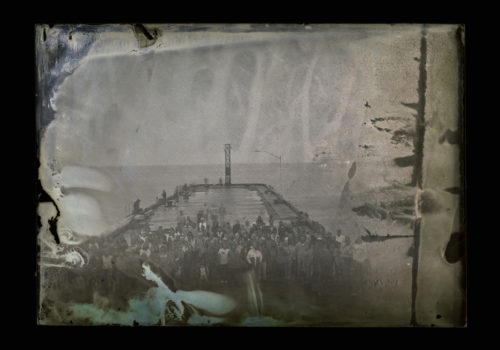For this third edition of the Rencontres Internationales in Gaspé, the photographer Maryse Goudreau mobilized large crowds on several abandoned docks along the coast. She did a lot to advertise these photo shoots open to the public where, from the top of a crane, she photographs village communities.
These docks, where once fishermen unloaded tons of cod per day, have fallen into disrepair. They evoke times past, difficult times, and the solidarities that hold despite it all. For each of these shots taken in different villages along the Gaspé coast, Goudreau brings together a few hundred people. She questions the social identity of the world that surrounds her, a world that is also hers, a world which she feels is more endangered than ever.
Maryse Goudreau lives in her own time, in Pointe-à-la-Croix, a small village situated between the Listuguj Indian reserve and the border with the neighboring Canadian province, New Brunswick, where in the 1760 Battle of the Restigouche the French lost their last hopes of taking America by force.
“At home, my father always set his watches and clocks to Quebec time. But my mother stayed on New Brunswick time,” in a different time zone. “Since my childhood, my parents have always lived an hour apart.” This constant preoccupation with time has haunted the photographer, and it shows in her work.
A stone’s throw from the old bridge that crosses the Restigouche River, where the freshwater flows into the Bay of Chaleur, Goudreau speaks softly and gladly shows the old mahogany viewfinder camera from 1870 that she uses for her work in collodion, the 19th century photography process, which she mastered in New York.
“Everyone wants to talk to me about my camera and how it works… I’m not here to demonstrate traditional methods in the digital age! Nobody seems concerned with why I use a camera like this, what it means for the work I’m trying to do, and how it fits into what I have always tried to do and understand. They always ask me the same questions, about the mechanics of it all… But that’s not what matters.”
Slow and complex, collodion photography marvelously underlines the relationship to memory that fascinates her. The handling of delicate glass plates and the uncertainties of the process emphasize the already palpable feeling of fragility in her progress toward a world that keeps receding. In the end, the photographer offers images filled with a veiled gentleness, where time seems to be carrying everything away, starting with the present.
Under Goudreau’s eye, her lens mounted on a brass rack captures less a precise image than an instant of a collective life where the photographer’s emotion covers everything. The chemical skin hanging from a simple glass plate allows the viewer to dive deeper into the fragility of time.
Although still very young, Maryse Goudreau has already completed several artist residencies abroad, including in the Middle East, Europe and the Caribbean. “I’ve traveled to around 20 countries, but where I felt the most out of place was in the native reservations near my home.”
During her studies, Goudreau worked in a photo agency in Paris that has since closed. Not one to hesitate flouting conventions, one evening she made an impromptu visit to a celebration at the prestigious Magnum agency. “We showed up at Magnum uninvited. We were underdressed, and we’d already had a quite a lot to drink… Henri Cartier-Bresson was there, and his wife Martine Franck, and other people, too, but I don’t remember much besides being there with them that night.”
Goudreau isn’t shy about her likes and dislikes. She doesn’t care for the pomp of high society. She loathes the nouveau riche aspect of modern America. And she doesn’t hide her political sympathies, which are social and focused on those left behind in today’s world, the same people who are the focus of her art.
That morning, Goudreau had been working since dawn to advertise her next photography project by putting up posters on one of the long, ghostly docks on the Gaspé. “Those are nice posters,” I told her. “But why did you only write what time the shoot is going to happen, and not the date?” She looked at me with big eyes. “Oh right, how stupid of me. I only wrote down the time.”
Jean-François Nadeau
















